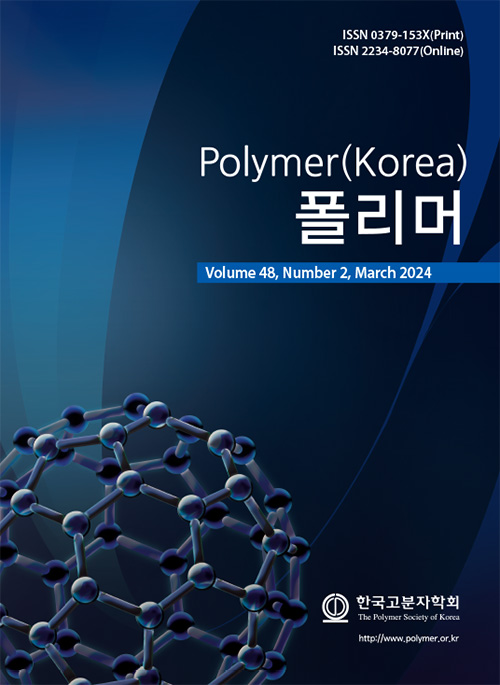- Characteristics of Eco-Friendly Epoxy Resin Modified with Epoxidized Soybean Oil (ESO): Thermal, Mechanical, and Morphological Properties
Dongwoo Electric Co., Ltd. R&D Center, 34, Osengseo-ro, Pyengtaek-si, Gyeonggi-do,17928 , Korea
*Division of Chemical Engineering, Dankook University, 126, Jukjeon-dong, Suji-gu, Gyeonggi-do, 16890, Korea- 에폭시화 대두유(ESO)로 개질된 친환경 에폭시 수지의 특성: 열적, 기계적 물성 및 모폴로지
동우전기㈜ 기술연구소, *단국대학교 화학공학과
Reproduction, stored in a retrieval system, or transmitted in any form of any part of this publication is permitted only by written permission from the Polymer Society of Korea.
A bisphenol-A epoxy resin mixed with epoxidized soybean oil (ESO) was cured with an acid anhydride curing agent and a tertiary amine accelerator. The thermal, mechanical, and morphological properties of the cured epoxy resin were investigated using thermogravimetric analyzer (TGA), dynamic mechanical analyzer (DMA), universal testing machine (UTM), impact tester, and scanning electron microscopy (SEM). As the content of ESO increased, the thermal stability and flexural strength decreased and the impact strength increased. This was thought to be due to the increase in phase separation in the ESO-rich region. As a result of DMA analysis and observation of morphology, it was determined that the increase in impact strength was due to the decrease in intermolecular crosslinking density due to the introduction of flexible long-chain ESO segments into the epoxy network structure and the absorption of external impact energy due to the increase in the roughness of the fracture surface. Therefore, it is believed that by mixing ESO in an appropriate amount with the epoxy resin according to the purpose and target properties, it is possible to manufacture a plant-based environmentally friendly epoxy resin capable of reducing carbon as well as improving impact strength.
에폭시화 대두유(ESO)를 혼합한 비스페놀에이형(bisphenol-A) 에폭시 수지를 산무수물 경화제와 제삼 아민계 촉진제로 경화시켰다. 경화된 에폭시 수지의 열적거동, 기계적 물성 및 모폴로지를 열중량분석기(TGA), 동력학적분석기(DMA), 만능시험기(UTM), impact tester, 주사전자현미경(SEM)을 이용하여 조사하였다. ESO의 함량이 증가함에 따라 열안정성과 굴곡강도는 감소하고 충격강도는 증가하였다. 이는 ESO가 풍부한 영역의 상분리가 증가하기 때문인 것으로 사료되었다. DMA 분석결과와 모폴로지를 관찰한 결과 충격강도의 증가는 에폭시 망상구조에 유연한 긴 사슬의 ESO 분절이 도입으로 인한 분자간 가교 밀도의 감소와 파단면의 거칠기 증가로 인한 외부 충격 에너지 흡수 때문인 것으로 판단되었다. 이에 용도 및 목표물성에 따라 ESO를 에폭시 수지에 적절한 양을 혼합함으로써 충격강도가 개선될 뿐 아니라 탄소절감이 가능한 식물계 친환경 에폭시 수지를 제조할 수 있으리라 사료된다.
Keywords: epoxidized soybean oil, environmentally friendly, impact strength, crosslinking density, plant-based.
- Polymer(Korea) 폴리머
- Frequency : Bimonthly(odd)
ISSN 0379-153X(Print)
ISSN 2234-8077(Online)
Abbr. Polym. Korea - 2023 Impact Factor : 0.4
- Indexed in SCIE
 This Article
This Article
-
2024; 48(2): 133-141
Published online Mar 25, 2024
- 10.7317/pk.2024.48.2.133
- Received on Aug 21, 2023
- Revised on Oct 10, 2023
- Accepted on Oct 10, 2023
 Correspondence to
Correspondence to
- Sangmook Lee
-
Division of Chemical Engineering, Dankook University, 126, Jukjeon-dong, Suji-gu, Gyeonggi-do, 16890, Korea
- E-mail: s_mlee@naver.com









 Copyright(c) The Polymer Society of Korea. All right reserved.
Copyright(c) The Polymer Society of Korea. All right reserved.